Well, the 235th AAS meeting in Hawaii is drawing to a close, but we can provide a few summaries of sessions on stellar imaging, using spectroscopy to measure stellar mass inflow and outflow, fast radio bursts, and how ancient Hawaiian navigators discovered the stars after losing sight of the land.
First up though, for all you astronomer wannabes,who have considered making a transition to remotely located and operated scopes, here is your chance to access data and images, for free, from a worldwide collection of telescopes. I have not yet downloaded these tools and tried doing any analysis of available images, but hope to do so shortly. If you like doing that type of thing, check out the tools and data at: http://www.worldwidetelescope.org/webclient/.
 |
| Explore terabytes of astronomical data on your own (Source: www.worldwidetelescope.org) |
Ok, so today I again followed my Hawaiian paradigm of astronomy in the morning and hooky in the afternoon. The morning sessions included more reviews of the history of astronomical techniques including the first century of stellar imaging.
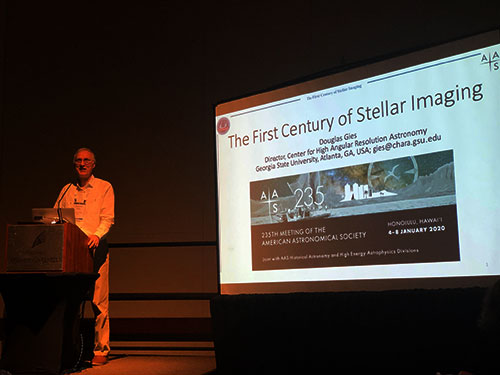 |
| Douglas Gies reviews the first century of stellar Imaging at AAS 235 (Source: Palmia Observatory) |
Stars are so far away that getting images of stars requires cameras with very large angular resolution which in most cases means use of interferometry. We heard about the early measurements by Hanbury Brown and Twiss and experiments conducted at Mt. Wilson on the 100 inch telescope. Using a 20 foot beam interferometer attached to the 100 inch telescope allowed Michelson and Pease to measure the size of Betelgeuse in 1920.
 |
| Douglas Gies reviews early size measurement by photon correlation at AAS 235 (Source: Palmia Observatory) |
John Monnier showed one of the first images of a star. We already have images of the sun, but other stars are so much further away. You can see in this image of Altair a possible hot spot or axis of rotation. These new techniques made possible further understanding of the processes and evolution of stars.
 |
| John Monnier reviews first image/rotation of Altair at AAS 235 (Source: Palmia Observatory) |
Andrea Dupree, CfA, adds spectroscopy to the imaging of stars. Spectroscopy and doppler shift measurements are her specialty. These new measurements bring a more precise understanding of stars which leads to new theories that can take advantage of the higher precision.
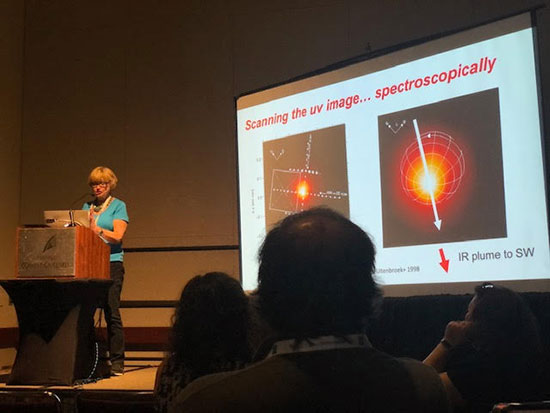 |
| Andrea Dupree, CfA, compares images and spectra of stars at AAS 235 (Source: Palmia Observatory) |
Andrea had several comments about Betelgeuse, which is the star, other than the sun, with the largest apparent angular size as seen from Earth. She went to comment about all of the Twitter activity on Betelgeuse and its continuing trend to its dimmest minimum brightness. She said we needn't worry about it blowing up anytime soon. She also gave a shout out to AAVSO which has been very helpful in collecting brightness of variable stars and how professional astronomers rely on that data for some of the their studies.
This next slide image shows how high resolution imaging and spectroscopy are used to measure the atmosphere and surface rotation effects and is used to measure the inflow and outflow of mass from the star.
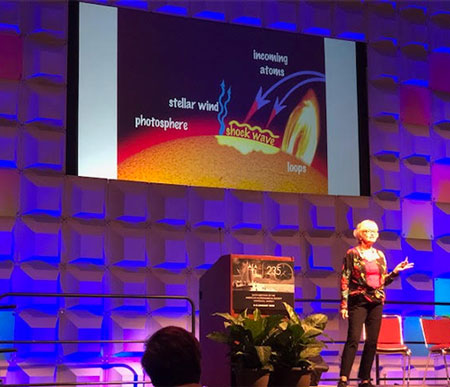 | |
|
Fast Radio Bursts (FRB) are short, millisecond pulse of radio energy that are detected on Earth and come from cosmological distances from unknown sources. The plenary session on FRBs with Jason Hessels, ASTRON, U. of Amsterdam, was a very interesting session.
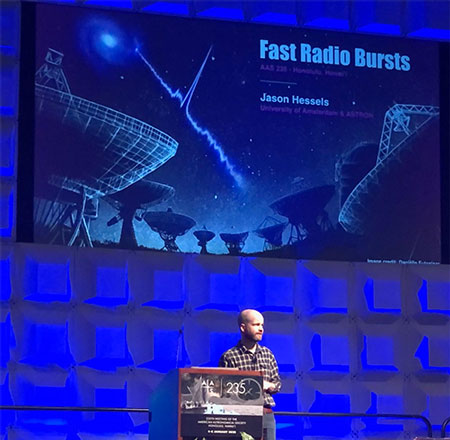 |
| Jason Hessels, U. of Amsterdam, makes presentation on Fast Radio Bursts at AAS 235 (Source: Palmia Observatory) |
The first FRB, called the Lorimer burst, after its discoverer, was identified in 2007. At first, there was a lot of skepticism about whether the signal was from a real astrophysical process or instead maybe just normal electrical interference in the observatory or Earth environment. But later, after similar FRBs were detected in other observatories, they then resulted in a more wide field search for what they were and where they come from.
The identifying feature of the FRBs is shown in the following screenshot from Hessels' slides. In the inset you can see the received time domain pulse and in the wider panel you can see the multichannel spectrum of the signal. What you see here is how the radio components of the pulse arrive at the detector at different times based on the frequency of the component. Normally, all radio frequencies travel at the same speed, that of light, but if the medium through which the signal propagates is ionized, then different frequencies travel at slightly different velocities. The lower the frequency, the slower the radio wave goes. This effect is called Dispersion Measure (DM). The amount of DM tells us something about how ionized the intervening medium is and something about the distance. Here the speed between the low frequency and high frequency components is only about 400 milliseconds after traveling over cosmological distances.
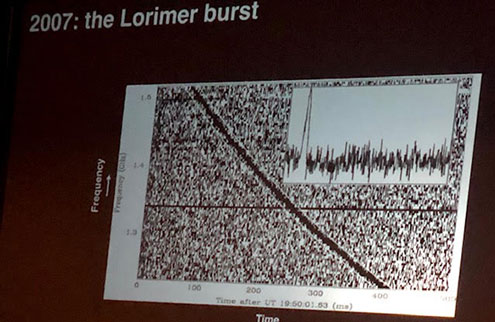 |
| Jason Hessels describes telltale multichannel signature of frequency dispersion of first FRB (Source: Palmia Observatory) |
What good are FRBs? They probe distant unknown processes and provide information regarding the medium through which the radio waves has traveled. It used to be thought that FRBs were one of a kind signal, from some cataclysmic explosion or event, but now that repeating FRBs, from the same distant object, have been observed, we know that some other process is going on. What that process is still remains unknown! There are several models of what they could be and new observations will hopefully start to rule out various contenders until their real nature is understood.
 |
| Hessels said FRBs are probes of distant unknown processes and intervening material at AAS 235 (Source: Palmia Observatory) |
The AAS meeting in Hawaii included a special plenary session recalling how over 4000 years ago groups of oceanic mariners set out to explore and colonize the Pacific. The plenary speaker, Chad Baybayan, U. of Hawaii, spoke of this history and how in modern times, a world wide cruise recreating some of the journey took place.
 |
| Chad Baybayan, U. of Hawaii, and daughter, Kala, at AAS 235 speak on sailing adventure (Source: Palmia Observatory) |
Professor Baybayan told of how the ancient mariners traveled using non-instrument navigation, only a star field in the skies. The pointed their canoes into the wind and traveled far to reach Hawaii and Easter Island (Rapa Nui) and other locations.
 |
| Chad Baybayan, U. of Hawaii, explores possible historical sailing routes at AAS 235 (Source: Palmia Observatory) |
The recreated sailing voyage traveled over 60,000 miles and took three years to complete. All in one iconic canoe. Baybayan and daughter, Kala, made a part of this voyage as father-daughter bonding experience and a reliving of some of the traditions of the ancient mariners.
 |
| Chad Baybayan, U. of Hawaii, describes the worldwide canoe voyage at AAS 235 (Source: Palmia Observatory) |
After hearing about the worldwide sailing adventure, I took off and walked back to Waikiki and decided to play hooky again. There was a light rain, but it was warm rain and it didn't last long and then this beautiful rainbow filled the whole sky.
 |
| It doesn't rain for long on Waikiki Beach, and its warm anyway, and ends in beautiful rainbow (Source: Palmia Observatory |
Playing hooky allows on to follow the rainbow into the local beach side bar where you can find again one of the many available colorful Hawaiian cocktails. I found I liked pretty much everything that I sampled. You normally get a little slice of pineapple with every drink, while each drink has its own special combination of orange, pineapple and mango juices, along of course with a shot of tequila, vodka, and/or rum altogether!
 |
| Beautiful, colorful island drinks remind us all of the beautiful rainbow (Source: Palmia Observatory |
At the weekend, there is a fireworks display on the beach at the Hilton Hawaiian Village Resort. A simple iPhone image provides some semblance of what was going on, but the overall effect of fireworks cannot be captured in a single image. It was a lot of fun just being on the beach and watching and hearing and feeling the fireworks go off!
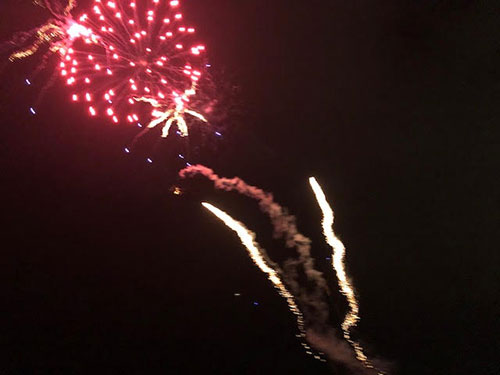 |
| Enjoyable fireworks on the beach at the Hilton Hawaiian Village (Source: Palmia Observatory) |
The next day was actually a free day so Resident Astronomer Peggy and I decided that that was our day for our night out at the Polynesian Luau. Now there a many available luaus but we elected to go to one of the best run by our friend, Moved to Hawaii and never Looked Back, Eddie! He has built a very successful entertainment business there. So, we showed up as his guests at Chiefs Luau in Kapolei, for a fantastic experience. Thanks for that Eddie and crew!
 |
| Chiefs Luau in Kapolei is the best for great food and fire dance Polynesian show (Sourc: www.chiefsluau.com) |
I guess we can't attend a luau and not mention the hula dancers, so here is the obligatory photo of the beautiful girls. Wow, can they really move!
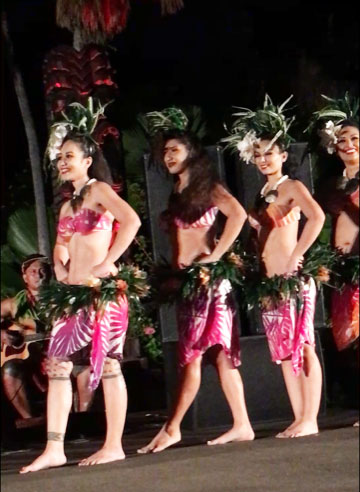 |
| Beautiful Hula dancers at Chiefs Luau (Source: Palmia Observatory) |
The final performance of the evening was the the Polynesian fire dance, which was conducted by Chief Siela and family. I had never witnessed this dance before and was really impressed with the finesse with which everyone could throw and handle the flaming spears. The whole stage seemed to a lit in fire at some times during the performance. As if that were not enough, the chief started the fire by rubbing two sticks together! Again, a simple iPhone image does not capture the grandeur and motion of the dance.
 |
| Chief Siela at Chefs Luau and family put on fantastic fire dance (Source: Palmia Observaory) |
So, we had a fantastic time at the luau and it was a most perfect way to pretty much bring our Hawaiian adventure to a close. We had been to Pearl Harbor before, so a luau was a great way to finish off the week of adventure, with some astronomy between bouts of hooky. So yes, after four Mai Tai's, some great food (beef, pork and fish), some hula dancing and a fantastic fire dance under the Hawaiian skies, it was easy to be relaxed, content and happy! Aloha!
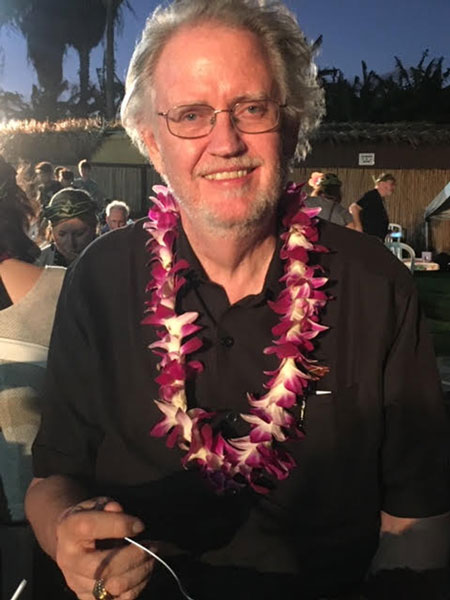 |
| Resident Astronomer is happy and satisfied at Chiefs Luau (Source: Palmia Observatory) |
Until next time,
Resident Astronomer George
Be sure to check out over 300 other blog posts on similar topics
If you are interested in things astronomical or in astrophysics and cosmology
Check out this blog at www.palmiaobservatory.com

No comments:
Post a Comment